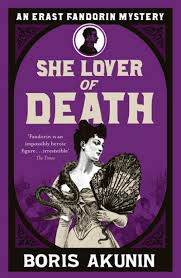
It seems it may no longer be possible to be “well-read”, although much depends on how you define the term.
Once, a reader who had read Shakespeare, Milton and works by a few of their contemporaries could claim to be well-read. Now, there are so many new books published each month that it sometimes feels impossible to be well-read, even within a favourite genre. I read many books which could fit under the label ‘crime’, yet I am constantly finding authors I had never heard of, like Boris Akunin.
Akunin, a Russian writer, has created a crime series featuring detective Erast Fandorin. I read the eighth installment, the oddly titled ‘She Lover of Death’.
What’s it about?
In 1900 in Moscow young bohemians are committing suicide with alarming frequency. Newspaper reporter Zhemailo investigates and uncovers a bizarre society, the Lovers of Death, led by a man calling himself Prospero. The members meet and share poetry until they are selected by death Herself and must commit suicide – after writing a final poem.
Private Investigator Erast Fandorin joins the society under an alias, concerned that something even darker is afoot. Meanwhile, Masha Mironova, a naïve young girl, finds herself swept up into the drama of the society. As the “aspirants” continue to die, can Fandorin uncover the secrets at the heart of the cult and save the lives of those remaining? His chances seem to decrease when Zhemailo dies mysteriously and Fandorin is selected by Death as her next bridegroom.
What’s it like?
This book is a slightly odd addition to Ajunin’s series as the principal character, Fandorin, is kept off centre-stage, despite playing a significant role. Readers who are new to the series will only recognise the detective from the reference in the blurb to a ‘Japanese prince’. Presumably, fans will recognise him more easily as he begins to state his deductions in a familiar form: ‘that is one…that is two…that is three.’
Increasing the distance between reader and detective, Akunin employs three self-important narrators. Zhemailo’s philosophical newspaper columns introduce readers to the idea of the society; the carefully worded diaries of young Masha, reborn in Moscow as Columbine, introduce the members of the society; and the letters from a police informant emphasise the dangers presented by the club and its manipulative leader. Each narrator tries to present a crafted image of themselves – as intrepid researcher, seductive bohemian and redeemable sinner – but all are equally self-obsessed and limited in their understanding. Readers have to work hard to discover the true nature of the society, its aspirants and its terrible leader.
Finally, in a lengthy dialogue that lasts thirty pages, Fandorin explains in detail exactly what has been happening and how, leaving the villain to explain why.
Or, rather, Fandorin does. He skulks about the victims’ houses, puzzling other characters who cannot fathom his motives, until he feels ready to confront the villain. In a thirty-page-long final chapter, Fandorin explains exactly what has been happening and how, leaving the villain to explain why. Apparently Akunin intended this book to be written in a style akin to Arthur Conan Doyle, which means this ending, allowing Fandorin to show off his intellect in front of a sneering villain, is highly appropriate. Unfortunately, I found the sheer length of the explanation rendered it rather dull.
Final thoughts
This was a difficult book to get absorbed in. Each narrator felt stylised and egotistical, which made them unappealing. Of course, it’s not essential to empathise with or even like a story’s characters, but if they aren’t particularly appealing then I need an engaging plot. This oblique way of telling a story meant the narrative was too drawn-out for me; I prefer a quicker pace.
There are plenty of opportunities to exercise your sleuthing skills along the way…Akunin includes interesting twists and turns throughout, even in the final pages.
Readers may really enjoy the slow build-up of details and focus on personalities followed by a detailed explanation of events. There are plenty of opportunities to exercise your sleuthing skills along the way: which member of the cult is Zhemailo? Which member is the letter-writer? (Are any of the members genuine members?!) What are Prospero’s true intentions? Akunin includes interesting twists and turns throughout, even in the final pages.
This book is best suited to the series’ fans. Relationships between the letter-writer and the police-officer and the police-officer and Fandorin were repeatedly hinted at but never revealed. This was a minor irritation, but it stung. A fan would have no difficulty in contextualising at least the latter relationship.
After publication, Akunin decided this was mere ‘one-handed clapping’ and he wrote an addition to the series entitled ‘He Lover of Death’, the events of which run in parallel to this book. It’s an interesting concept, but I’m not inspired enough by Akunin’s plotting to look it out.


